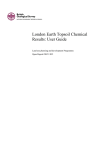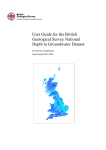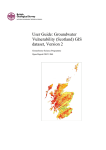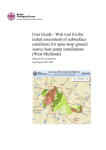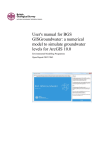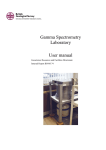Download R-Groundwater: model user's manual for NERC Virtual Observatory
Transcript
R-Groundwater: model user's manual for NERC Virtual Observatory implementation Groundwater Science Programme Open Report OR/11/059 Actual Evaporation Precipitation Soil Moisture Model (soil, landuse) Runoff FAO 56 Excess water Potential recharge Soil drainage spread over n months according to Weibull distribution Unsaturated Zone Transfer function Actual recharge Kw Qw hw Kp hp Qp S Ka z ha Qa BRITISH GEOLOGICAL SURVEY GROUNDWATER SCIENCE PROGRAMME OPEN REPORT OR/11/059 R-Groundwater: model user's manual for NERC Virtual Observatory implementation The National Grid and other Ordnance Survey data are used with the permission of the Controller of Her Majesty’s Stationery Office. Licence No:100017897/2007. C R Jackson and L Wang Keywords Lumped groundwater model; R code; NERC Virtual Observatory;. Front cover Structure of R-Groundwater model. Bibliographical reference JACKSON, C R AND WANG, L. 2011. R-Groundwater: model user's manual for NERC Virtual Observatory implementation. British Geological Survey Open Report, OR/11/059. 19pp. Copyright in materials derived from the British Geological Survey’s work is owned by the Natural Environment Research Council (NERC) and/or the authority that commissioned the work. You may not copy or adapt this publication without first obtaining permission. Contact the BGS Intellectual Property Rights Section, British Geological Survey, Keyworth, e-mail [email protected]. You may quote extracts of a reasonable length without prior permission, provided a full acknowledgement is given of the source of the extract. Maps and diagrams in this book use topography based on Ordnance Survey mapping. © NERC 2011. All rights reserved Keyworth, Nottingham British Geological Survey 2011 BRITISH GEOLOGICAL SURVEY The full range of our publications is available from BGS shops at Nottingham, Edinburgh, London and Cardiff (Welsh publications only) see contact details below or shop online at www.geologyshop.com The London Information Office also maintains a reference collection of BGS publications including maps for consultation. The Survey publishes an annual catalogue of its maps and other publications; this catalogue is available from any of the BGS Sales Desks. The British Geological Survey carries out the geological survey of Great Britain and Northern Ireland (the latter as an agency service for the government of Northern Ireland), and of the surrounding continental shelf, as well as its basic research projects. It also undertakes programmes of British technical aid in geology in developing countries as arranged by the Department for International Development and other agencies. The British Geological Survey is a component body of the Natural Environment Research Council. British Geological Survey offices BGS Central Enquiries Desk 0115 936 3143 email [email protected] Fax 0115 936 3276 Kingsley Dunham Centre, Keyworth, Nottingham NG12 5GG 0115 936 3241 Fax 0115 936 3488 email [email protected] Murchison House, West Mains Road, Edinburgh EH9 3LA 0131 667 1000 Fax 0131 668 2683 email [email protected] London Information Office, Natural History Museum, Cromwell Road, London SW7 5BD SW7 2DE 020 7589 4090 Fax 020 7584 8270 020 7942 5344/45 email [email protected] Columbus House, Greenmeadow Springs, Tongwynlais, Cardiff CF15 7NE 029 2052 1962 Fax 029 2052 1963 Forde House, Park Five Business Centre, Harrier Way, Sowton EX2 7HU 01392 445271 Fax 01392 445371 Maclean Building, Crowmarsh Gifford, Wallingford OX10 8BB 01491 838800 Fax 01491 692345 Geological Survey of Northern Ireland, Colby House, Stranmillis Court, Belfast BT9 5BF 028 9038 8462 Fax 028 9038 8461 www.bgs.ac.uk/gsni/ Parent Body Natural Environment Research Council, Polaris House, North Star Avenue, Swindon SN2 1EU Fax 01793 411501 01793 411500 www.nerc.ac.uk Website www.bgs.ac.uk Shop online at www.geologyshop.com OR/11/059 Contents 1 Structure of lumped catchment groundwater model 1.1 Soil moisture balance model 1.2 Unsaturated zone transfer function 1.3 Lumped catchment groundwater model 1 2 3 4 2 Application of the model 2.1 Input files 7 7 References 13 FIGURES Figure 1 Structure of R-Groundwater ............................................................................... 1 Figure 2 Example Weibull probability density function .................................................. 4 Figure 3 Basic structure of lumped catchment groundwater model ................................. 5 Figure 4 Example lumped groundwater model structure for application to a Chalk aquifer................................................................................................................. 6 Figure 5 Observed and simulated hydrograph for the Baydon Hole borehole, Berkshire Downs................................................................................................................. 7 TABLES Table 1 Summary of model parameters .......................................................................... 8 Table 2 Format of main input file “Input.txt” ................................................................. 9 Table 3 Format of observed groundwater level input file ............................................. 10 Table 4 Format of rainfall and PE input file ................................................................. 10 Table 5 Example R file in which recharge model parameter ranges are defined .......... 11 Table 6 Example R file in which groundwater model parameter ranges are defined ... 12 i OR/11/059 Summary This report describes the structure and usage of the R-Groundwater model for implementation within the NERC Virtual Observatory project. R-Groundwater is a simple lumped catchment groundwater model written in the R programming language and run within the R environment. It has been developed to model groundwater level time series at observation boreholes by linking simple algorithms to simulate soil drainage, the transfer of water through the unsaturated zone and groundwater flow. Time-series of flow through the outlets of the groundwater store are also generated, which can be related to river flow measurements. The model is calibrated through a Monte Carlo process by randomly selecting input parameter values from ranges specified by the user. Simple text files are used to define the input to the model and to write the output. ii OR/11/059 1 Structure of lumped catchment groundwater model The R-Groundwater model consists of three components: 1. A soil moisture balance model producing a time-series of potential recharge (soil drainage). 2. A simple transfer function representing the delay in the time of the arrival of recharge from the base of the soil to the water table. 3. A lumped catchment groundwater model based on a simple Darcian representation of flow out of a series of aquifer “outlets”. Each of these components is described in the following subsections. The structure of the model is shown in Figure 1. Actual Evaporation Precipitation Soil Moisture Model (soil, landuse) Runoff FAO 56 Excess water Potential recharge Soil drainage spread over n months according to Weibull distribution Unsaturated Zone Transfer function Actual recharge Kw Qw hw Kp hp Qp S Ka z Qa ha Figure 1 Structure of R-Groundwater 1 OR/11/059 1.1 SOIL MOISTURE BALANCE MODEL Potential recharge from the base of the soil zone is calculated using the FAO method (FAO, 1998), which describes soil moisture as a function of both vegetation root depth, and the propensity of vegetation to withdraw available water from the soil. Thus, this approach can appropriately represent soil moisture response to contrasting land-cover types. In the FAO method, soil moisture is calculated using a maximum root depth (Zr), and moisture depletion fraction (dp) parameter, which varies between vegetation and soil types. The amount of water available to plants after a soil has drained to its field capacity, is described as the total available water (TAW). TAW is defined as a function of the field capacity (FC), wilting point (WP) and maximum root depth (Zr) such that: TAW Z r FC WP Equation 1 As the moisture content of the soil column decreases, vegetation will find it more difficult to extract moisture from the soil matrix. The fraction of TAW that can easily be extracted before this point, is reached is described as readily available water (RAW). The value of RAW is related to TAW by a land-cover defined depletion factor (dp): RAW = dp TAW Equation 2 where Rf is the rainfall and SMD is the soil moisture deficit. The intermediate soil moisture deficit, SMD ' , is then: SMD ' SMD t 1 PE ' Rf Equation 3 where PE ' is the potential evaporation. If in the above calculation SMD drops below RAW, the evaporation, AE, will take place at a lower rate determined by the equation: TAW SMD` AE PE ' TAW RAW 0.2 when SMD` > RAW Equation 4a AE PE ' when SMD` ≤ RAW Equation 4b AE 0 when SMD` TAW Equation 4c The calculation of SMD at the end of each timestep is then made with respect to the above, such that: SMD( t ) SMD' AE PE ' Equation 5 2 OR/11/059 The excess water (EXW), or the amount of water that is available for surface runoff and potential groundwater recharge, is calculated as the amount of precipitation remaining after losses through interception, evapotranspiration, and soil moisture replenishment, such that: EXW Rf AE (SMD ( t 1) SMD ( t ) ) when SMD 0 Equation 6a EXW SMD when SMD < 0 Equation 6b The potential recharge, PR, is then calculated as: PR BFI EXW Equation 7 where BFI is the baseflow index. The parameters for FAO method can be based on those given in the FAO Irrigation and Drainage Paper 56 (FAO, 1998). 1.2 UNSATURATED ZONE TRANSFER FUNCTION A commonly applied transfer function as used by Calver (1997) is the basis for the transfer of potential recharge from the base of the soil zone through the unsaturated zone to the water table. Potential recharge from the base of the soil in each month is applied to the water table over the current month and a number of subsequent months. The total number of months, n, over which recharge is distributed is a model parameter. The distribution of recharge over the n months is specified using a two-parameter Weibull probability density function: k x k 1 x / k e f x ; , k 0 x 0, Equation 8 x 0, where k > 0 is the shape parameter and λ >0 is the scale parameter of the distribution. The resulting distribution is scaled such that the area under the curve is equal to unity and consequently the recharge for each time-step is simply spread over the selected, n, number of months. This Weibull function can represent exponentially increasing, exponentially decreasing, and positively and negatively skewed distributions as illustrated in Figure 2. It is used because it is smooth and considered to be more physically justifiable than randomly selected monthly weights. 3 OR/11/059 Figure 2 1.3 Example Weibull probability density function LUMPED CATCHMENT GROUNDWATER MODEL Flow of saturated groundwater is represented by a rectangular block of aquifer. In the following description the aquifer is assumed to be unconfined but different aquifer conceptualisations can easily be accommodated. A simple, explicit mass balance calculation is performed at each time-step to calculate the new groundwater head. With reference to Figure 3 this mass balance is formulated as: R x y Q S x y h / t Equation 9 where R is recharge [LT-1], Δx and Δy are the length and width of the aquifer [L], Q is the groundwater discharge [L3T-1], S is the storage coefficient [-], δh is the change in groundwater head [L] over time, δt [T] and h is the groundwater head [L]. The discharge term, Q, is calculated using an equation of the form: Q T y h 0.5x Equation 10 where Δh [L] is the difference between the groundwater head and the elevation of an aquifer outlet point and T is the appropriately calculated transmissivity [L2T-1]. 4 OR/11/059 R Q h Dy Dx Figure 3 Basic structure of lumped catchment groundwater model Groundwater flow out of the aquifer is split into a series of discharges via outlets at different elevations. Each of these outlets is associated with a vertical section of aquifer to which a value of hydraulic conductivity is specified (Figure 4). The aquifer is drained by a stream with perennial (Qp) and intermittent (Qw) flow components. A third discharge component (Qa) is added at the base of the system to represent groundwater discharge below the level of a perennial stream. The groundwater level may fall beneath the level of the perennial stream (hp) but will always be above the base of the aquifer (Zb). Hydraulic conductivity is defined using three piecewise constant values. The section of the aquifer discharging to the intermittent stream (above hw) is characterised by hydraulic conductivity, Kw. The perennial stream is fed by a zone with hydraulic conductivity, Kp; and the groundwater discharge zone (below hp) is controlled by a hydraulic conductivity, Ka. The storativity of the aquifer is depth invariant. The discharge terms, Q, are again calculated using Equation 3 where Δh [L] is the difference between the groundwater head and the elevation of the outlet below, or the difference in elevation between two outlets, depending on the current groundwater head, and T is the appropriately calculated transmissivity [L2T-1]. 5 OR/11/059 R Kw Qw hw Kp hp Qp S Ka Qa ha z Figure 4 Example lumped groundwater model structure for application to a Chalk aquifer 6 OR/11/059 2 Application of the model The model is written in the R programming language. Individual models of groundwater level hydrographs are calibrated through a Monte Carlo process in which parameter values are sampled from user defined ranges. All of the model parameters can be defined as calibration parameters, however, some can be identified reasonably accurately based on hydrogeological judgment and are therefore fixed. A summary of the parameters for the model shown in Figure 4, and the data used to determine Monte Carlo calibration ranges for them, are listed in Table 1. An example comparison between an observed and simulated chalk hydrograph using this model is shown in Figure 5. Figure 5 2.1 Observed and simulated hydrograph for the Baydon Hole borehole, Berkshire Downs. INPUT FILES The model requires five input text files containing: 1. Model control parameters. 2. A times series of observed groundwater levels against which the model is calibrated. 3. Time-series of rainfall and potential evaporation. 4. An R file in which parameter value ranges for the soil moisture balance model and recharge transfer function are specified. 5. An R file in which parameter value ranges for the saturated groundwater model component are specified. The format of these files is presented in Table 2 to Table 6. 7 OR/11/059 Table 1 Summary of model parameters Saturated zone Unsaturated zone transfer Soil moisture balance Model component Parameter Data informing parameter estimation Runoff coefficient, RO River base flow indices (1-BFI). Field capacity, FC FAO Irrigation and Drainage paper 56 (FAO 1998). Wilting point , WP FAO Irrigation and Drainage paper 56 (FAO 1998). Maximum rooting depth, Zr FAO Irrigation and Drainage paper 56 (FAO 1998). Depletion factor, dp FAO Irrigation and Drainage paper 56 (FAO 1998). Number of months over which to distribute potential recharge, n Cross-correlation of monthly groundwater levels and lagged monthly rainfall. Weibull shape parameter, k Calibration parameter but varied between values that allows a broad range of distributions to be tested. Weibull shape parameter, Calibration parameter but varied between values that allows a broad range of distributions to be tested. Elevation of intermittent stream outlet, hw DTM elevation of intermittent streams. Elevation of Perennial stream outlet, hp DTM elevation of perennial streams. Elevation of groundwater discharge outlet, ha Geological and hydrogeological boreholes logs. Hydraulic conductivity, of upper aquifer (above hw), Kw Calibration ranges based on pump test data and hydrogeological experience. Hydraulic conductivity, of middle aquifer (between hw and hp), Kp Calibration ranges based on pump test data and hydrogeological experience. Hydraulic conductivity, of lower aquifer (between hp and ha), Ka Calibration ranges based on pump test data and hydrogeological experience. Storativity of aquifer, S Calibration ranges based on pump test data and hydrogeological experience. 8 OR/11/059 Table 2 Format of main input file “Input.txt” Line 1 2 3 4 5 6 7 8 9 10 11 12 13 14 15 16 17 18 19 20 21 22 23 24 25 26 27 28 29 30 31 File contents ‐‐‐‐ Using the output from a previous run? (Y or N) N ‐‐‐‐ If Y, run all behavioural models (i.e. that met error criterion)? (Y or N) N ‐‐‐‐ If N, specify the number of best models to be used? 10 ‐‐‐‐ Recharge parameter input R file name Recharge_Model_Parameters.txt ‐‐‐‐ Groundwater parameters input R file name? Groundwater_Model_Parameters.txt ‐‐‐‐ Simulation start end date (format DD‐MM‐YYYY) 15/01/1970 15/12/1989 ‐‐‐‐ Initial groundwater level 16.8175 ‐‐‐‐ Number of Monte Carlo calibration runs 1000000 ‐‐‐‐ Rainfall and PE data file name Rainfall_PE.txt ‐‐‐‐ Groundwater level file name Groundwater_levels.txt ‐‐‐‐ Input directory E:\NERC_VO_VERSION\ ‐‐‐‐ Output directory E:\NERC_VO_VERSION\Results\ ‐‐‐‐ Run name Example ‐‐‐‐ Error measure flag: 1=RMSE, 2=COREL, 3=RMSE of extreme values, 4=NSE 1 ‐‐‐‐ Error measure value (only those meeting criterion are stored) 1.7 9 Description Comment line Flag to determine if running previously calibrated models Comment line Flag to determine if should re‐run all behavioural models Comment line If re‐running subset of behavioural models how many should be run? Comment line Name of recharge model parameter input file Comment line Name of recharge model parameter input file Comment line Simulation start date in dd/mm/yyyy format Simulation end date in dd/mm/yyyy format Comment line Initial groundwater head (m) Comment line Number of simulations in Monte Carlo run Comment line Name of rainfall and PE input file Comment line Name of input file containing observed groundwater levels Comment line Input directory path Comment line Output directory path (must exist before model is run) Comment line Name of run which forms start of output file names Comment line Flag specifying which error measure to use Comment line Error measure limiting criterion value for identifying behavioural models OR/11/059 Table 3 Format of observed groundwater level input file File contents dt gwl 1970‐01‐15 16.82 1970‐02‐15 20.88 1970‐03‐15 22.40 1970‐04‐15 21.81 1970‐05‐15 21.91 1970‐06‐15 20.66 1970‐07‐15 19.46 1970‐08‐15 17.96 1970‐09‐15 16.68 1970‐10‐15 15.46 1970‐11‐15 14.28 1970‐12‐15 13.75 1971‐01‐15 14.39 1971‐02‐15 16.18 1971‐03‐15 19.42 etc Description Header containing string “dt gwl” Date in yyyy‐mm‐dd format and groundwater level A space separated file Table 4 Format of rainfall and PE input file File contents dt pptn pe 1970‐01‐15 72.0 12.0 1970‐02‐15 70.9 24.2 1970‐03‐15 65.0 40.6 1970‐04‐15 43.3 56.2 1970‐05‐15 90.8 82.8 1970‐06‐15 10.4 85.6 1970‐07‐15 14.0 92.8 1970‐08‐15 96.9 77.2 1970‐09‐15 52.3 61.4 1970‐10‐15 22.5 44.1 1970‐11‐15 46.0 26.4 1970‐12‐15 124.0 12.4 1971‐01‐15 47.6 11.0 etc Description Header containing string “dt pptn pe” Date in yyyy‐mm‐dd format followed by rainfall (mm) and PE (mm) A space separated file 10 OR/11/059 Table 5 Example R file in which recharge model parameter ranges are defined # Name of rainfall file? Change the name inside the "" df.Rain.File=read.table("Rainfall_PE.txt",header=T) # DO NOT MODIFY THE FOLLOWING 3 LINES dt.Date.In=as.POSIXct(df.Rain.File$dt) nu.Recharge.In=df.Rain.File$pptn/1000 nu.PE.In=df.Rain.File$pe/1000 # Parameters for the UZ transfer funtion # Are the number of weights random or specfied (S/R)? (keep the " ") ch.Calver.Weights.Choice="R" # If R (random) give the range of the number of months over which potential recharge is spread nu.Calver.Range.U=c(12,12) # If S (specified) then give the monthly weights # Monthly weights for transfer function (u) nu.U=c(0.2,0.4,0.3,0.1) # Are the Weibull distribution k and lambda random or specfied (S/R)? (keep the " ") ch.Calver.Weibull.param.Choice="S" # Range for Weibull distribution shape parameter k nu.Wk.Range=c(2,6) # Range for Weibull distribution scale parameter lambda nu.Wlambda.Range=c(1.8,3.0) # Runoff coefficient value equals one minus the base flow index nu.ROCoeff=c(0.01,0.3) # Soil parameter values ranges nu.FC=c(0.2904,0.2904) nu.WP=c(0.1529,0.1529) nu.Zr=c(0.5,1.3) nu.dp=c(0.02,0.2) nu.SMDStart=c(0.0,0.0) nu.PEAEFrac=c(0.1,0.1) 11 OR/11/059 Table 6 Example R file in which groundwater model parameter ranges are defined #‐‐‐‐‐‐‐‐‐‐‐‐‐‐‐‐‐‐‐‐‐‐‐‐‐‐‐‐‐ # SET PARAMETER RANGES BY CHANGING VALUES WITHIN c( , ) # Length of aquifer nu.Length=c(4408,4408) # Kw ‐ Hydraulic conductivity for heads > Hw nu.K.High=c(30,50) # Kp ‐ Hydraulic conductivity for heads > Hp nu.K.Low=c(30,45) # Ka ‐ Hydraulic conductivity for < Hp nu.K.Base=c(0.02,0.2) # S ‐ Storage coefficient nu.S.Low=c(0.01,0.03) # Ha ‐ Base elevation of the aquifer nu.H.Low=c(‐46,‐46) # Hp ‐ Outlet elevation for perennial river nu.H.Mid=c(4,8) # Hw ‐ Outlet elevation for ephemeral river nu.H.High =c(6,23.5) #‐‐‐‐‐‐‐‐‐‐‐‐‐‐‐‐‐‐‐‐‐‐‐‐‐‐‐‐‐ # DO NOT ALTER DATA BELOW HERE # Dummy variables nu.T.Low=c(10,500) nu.T.High=c(500,5000) nu.S.High=c(0.003,0.003) nu.H.Mid2=c(120,140) 12 OR/11/059 References CALVER A. 1997. Recharge Response Functions. Hydrology and Earth System Sciences 1: 47-53. FAO, 1998. Crop evapotranspiration; guidelines for computing crop water requirements, FAO Irrigation and Drainage Paper 56, Rome, 301pp. 13




















